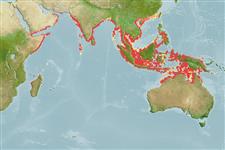Actinopterygii (ray-finned fishes) >
Clupeiformes (Herrings) >
Clupeidae (Herrings, shads, sardines, menhadens) > Dorosomatinae
Etymology: Hilsa: Bangladesh and Bengali local name for a fish.
Environment / Climate / Range
Ecology
Marine; freshwater; brackish; pelagic-neritic; anadromous (Ref. 51243); depth range 10 - ? m (Ref. 30573). Tropical, preferred 28°C (Ref. 107945); 25°N - 18°S, 43°E - 155°E (Ref. 54554)
Indo-West Pacific: probably all coasts of Indian Ocean, from Gulf of Oman and Gulf of Aden south to Transkei, South Africa and Madagascar, across the Bay of Bengal, Gulf of Thailand, Java Sea and north to Hong Kong and east to Papua New Guinea and possibly further.
Length at first maturity / Size / Weight / Age
Maturity: Lm 15.0 range ? - ? cm
Max length : 35.0 cm TL male/unsexed; (Ref. 11228); common length : 16.5 cm SL male/unsexed; (Ref. 188)
Dorsal
spines
(total): 0;
Dorsal
soft rays
(total): 16-19;
Anal
spines: 0;
Anal
soft rays: 21 - 23. Top of head with numerous fronto-parietal striae; upper jaw with median notch. gill rakers about 100 to 175, those on inner arches distinctly curled; outer row of gill filaments on first arch not more than half length of gill rakers. A series of small triangular scales above axil of pectoral fin; hind part of body scales perforated. A black spot behind gill opening; usually 10 along flank.
Found in coastal waters (Ref. 30573), enters estuaries and able to tolerate quite low salinities (7 ppt). Feeds chiefly on phytoplankton (mainly diatoms, also dinoflagellates), but also copepods, molluscan and crustacean larvae, prawns, amphipods and polychaetes. Spawns (at least in Godavari estuary) around February (Ref. 188). Marketed fresh, dried, dried-salted and boiled. Made into fish balls. Found in the basin-wide mainstream of the lower Mekong (Ref. 36667).
Whitehead, P.J.P., 1985. FAO Species Catalogue. Vol. 7. Clupeoid fishes of the world (suborder Clupeioidei). An annotated and illustrated catalogue of the herrings, sardines, pilchards, sprats, shads, anchovies and wolf-herrings. FAO Fish. Synop. 125(7/1):1-303. Rome: FAO. (Ref. 188)
IUCN Red List Status (Ref. 115185)
CITES (Ref. 94142)
Not Evaluated
Threat to humans
Harmless
Human uses
Fisheries: highly commercial; bait: occasionally
More information
ReferencesAquacultureAquaculture profileStrainsGeneticsAllele frequenciesHeritabilityDiseasesProcessingMass conversion
Tools
Special reports
Download XML
Internet sources
